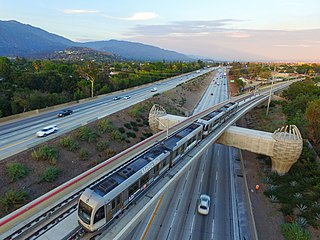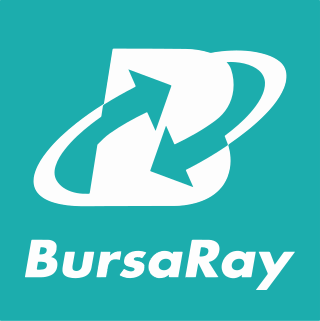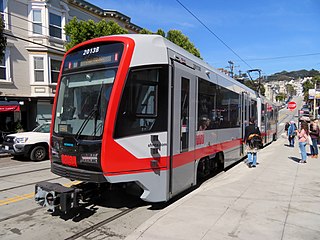
The Siemens–Duewag U2 is a type of light rail vehicle (LRV), built by consortium of Siemens, Duewag and Wegmann & Co built between 1968 and 1990.

The SD-100 and SD-160 are light rail vehicles (LRV) that were manufactured by Siemens Mobility between 1992 and 2013 for the North American market. The vehicles were all constructed at the Siemens facility in Florin, California.

The A Line is a 48.5-mile (78.1 km) light rail line in Los Angeles County, California. It is one of the six lines of the Los Angeles Metro Rail system, operated by the Los Angeles County Metropolitan Transportation Authority (Metro). The A Line serves 44 stations and runs east-west between Azusa and Pasadena, then north-south between Pasadena and Long Beach. It interlines and shares five stations with the E Line in Downtown Los Angeles. Service operates for approximately 19 hours with headways of up to 8 minutes during peak hours. The A Line is currently the longest light rail line in the world.

The Siemens S70 and its successor, the Siemens S700, are a series of low-floor light-rail vehicles (LRV) and modern streetcars manufactured for the United States market by Siemens Mobility, a division of German conglomerate Siemens AG. The series also includes a European tram-train variant, the Siemens Avanto.

The C Line is a 19.3-mile (31.1 km) light rail line running between Redondo Beach and Norwalk within Los Angeles County, California. It is one of six lines forming the Los Angeles Metro Rail system and opened on August 12, 1995. Along the route, the line serves the cities of Downey, El Segundo, Hawthorne, Norwalk and Lynwood, the Los Angeles community of Westchester, and several unincorporated communities in the South Los Angeles region including Athens, Del Aire, and Willowbrook. A free shuttle bus to Los Angeles International Airport (LAX) is available at the line's Aviation/LAX station.
Kinki Sharyo Co., Ltd. is a Japanese manufacturer of railroad vehicles based in Osaka. It is an affiliate company of Kintetsu Corporation. In business since 1920 as Tanaka Rolling Stock Works, and renamed The Kinki Sharyo Co., Ltd in 1945, they produce rolling stock for numerous transportation agencies, ranging from Shinkansen high-speed trains to light rail vehicles. Kinki Sharyo is listed on the Tokyo Stock Exchange as TYO: 7122.

CRRC Changchun Railway Vehicles Co., Ltd. is a Chinese rolling stock manufacturer and a division of the CRRC. While the CRV emerged in 2002, the company's roots date back to the establishment of the Changchun Car Company in 1954. The company became a division of CNR Corporation before its merger with CSR to form the present CRRC. It has produced a variety of rolling stock for customers in China and abroad, including locomotives, passenger cars, multiple units, rapid transit and light rail vehicles. It has established technology transfer partnerships with several foreign railcar manufacturers, including Bombardier Transportation, Alstom, and Siemens Mobility.

CRRC Zhuzhou Locomotive Co., Ltd. is one of the electric locomotive manufacturers in China. It is one of the subsidiaries of CRRC.

Bursaray is a rapid transit system in the city of Bursa, Marmara Region, Turkey, built in 2000 by TÜVASAŞ, and operated by Burulaş. The name Bursaray is a portmanteau of Bursa, and Ray, the Turkish word for "rail". The Bursaray metro opened for passenger service on 24 April 2002. The metro system presently consists of two lines, which share a main line in the east, and branch into two lines at the western end of the system.

The A650 is an electric multiple unit rapid transit car built for use on the Los Angeles Metro Rail system. The cars were manufactured by the Italian company Breda at its Pistoia plant in Italy between 1988 and 1997 and are used on the Metro B and D Lines.
The opening of the Metro Blue Line in 2004 marked the beginning of Metro Transit's expansion into rail transit, 50 years after the last Twin Cities Rapid Transit streetcars were taken out of service. Several new rail transit projects are either under construction or in planning stages and more are expected to be explored in the near future. Metro Transit will likely be acquiring a significant amount of rolling stock as these new projects move forward.
The Los Angeles County Metropolitan Transportation Authority (Metro) operates six rail lines as part of its Metro Rail system. This system includes four light rail lines and two rapid transit lines. The agency owns, operates, and maintains a fleet of 439 rail vehicles.

The Siemens S200 is a high-floor light rail vehicle (LRV) manufactured by Siemens Mobility in Florin, California. The S200 succeeds the SD-100, SD-160, SD-400 and SD-460 as the high-floor light rail vehicle for the North American market and is being manufactured and marketed alongside the low-floor Siemens S700.

The Siemens SD-400 and SD-460 are light rail vehicles (LRV) that were manufactured by Siemens Mobility between 1985 and 2005 for the North and South American markets. The SD-400 was built under Siemens' joint venture with Duewag and assembled at both Duewag's factory in Düsseldorf, West Germany and the Siemens factory in Florin, California. Siemens purchased Duewag in 1999 and the SD-460 was assembled entirely at the Siemens factory in California.

The P865 and P2020 are retired articulated light rail vehicles used on the Los Angeles Metro Rail system. They were manufactured by Nippon Sharyo and used on the A, C (P2020), and E lines.

The P3010 is an articulated light rail car used on the Los Angeles Metro Rail system manufactured by Kinki Sharyo, operated on all of the Metro Rail light rail lines.

Sacramento RT Light Rail is a 42.9-mile (69.0 km) light rail system that serves the Sacramento, California area. It consists of three rail lines, 53 stations, and a fleet of 96 vehicles. It is operated by the Sacramento Regional Transit District (RT). With an average of 22,200 weekday daily boardings as of the fourth quarter of 2023, the RT light rail system is the thirteenth busiest in the United States.

The TriMet transit system, serving the Portland metropolitan area in Oregon, owns and operates two different rail transit systems: a light rail system known as MAX, and a commuter rail system known as WES. The fleet of 145 MAX electric light rail vehicles (LRVs) includes five different models, designated by TriMet as "Type 1" through "Type 6". All types are used on all of the MAX lines, but the Type 6 cars – which will gradually replace the Type 1 cars – are still being delivered and have not yet begun to enter service. The comparatively very small WES fleet includes three different types of diesel commuter rail cars.

The Siemens SD660, originally known as the Siemens SD600, is a double-articulated, 70%-low-floor light rail vehicle (LRV) manufactured by Siemens Transportation Systems. It was the first low-floor light rail vehicle to be used in the United States. It first entered service in 1997 with its only operator, TriMet, on the MAX light rail system in Portland, Oregon, United States.

The P2550 is an articulated high-floor electric light rail vehicle manufactured by AnsaldoBreda for the Los Angeles County Metropolitan Transportation Authority's Metro Rail system.


















